Creating Forested Wetlands for Improving Ecosystem Services and Their Potential Benefits for Rural Residents in Metropolitan Areas
Abstract
1. Introduction
2. Materials and Methods
2.1. The Creation of Green Treasure Island
2.2. Ecological Monitoring
2.2.1. Water Quality
2.2.2. Bird Survey
3. Results
3.1. The Agricultural Runoff Treatment and Flood Control
3.2. The Bird Attraction
3.3. Other Critical Services Provided by Green Treasure Island
4. Discussion
5. Conclusions
Author Contributions
Funding
Data Availability Statement
Conflicts of Interest
References
- Irwin, E.G.; Bockstael, N.E. The evolution of urban sprawl: Evidence of spatial heterogeneity and increasing land fragmentation. Proc. Natl. Acad. Sci. USA 2007, 104, 20672–20677. [Google Scholar] [CrossRef] [PubMed]
- Johnson, M.P. Environmental impacts of urban sprawl: A survey of the literature and proposed research agenda. Environ. Plan. A Econ. Space 2001, 33, 717–735. [Google Scholar] [CrossRef]
- Su, S.L.; Jiang, Z.L.; Zhang, Q.; Zhang, Y.A. Transformation of agricultural landscapes under rapid urbanization: A threat to sustainability in Hang-Jia-Hu region, China. Appl. Geogr. 2011, 31, 439–449. [Google Scholar] [CrossRef]
- Reis, B.P.; Branquinho, C.; Torok, K.; Rehounková, K.; Nunes, A.; Halassy, M. The added value of the long-term ecological research network to upscale restoration in Europe. J. Environ. Manag. 2024, 366, 121736. [Google Scholar] [CrossRef]
- Vymazal, J. Constructed Wetlands for Wastewater Treatment. Water 2010, 2, 530–549. [Google Scholar] [CrossRef]
- Garcia-Polo, J.; Falkowski, T.B.; Mokashi, S.A.; Law, E.P.; Fix, A.J.; Diemont, S.A.W. Restoring ecosystems and eating them too: Guidance from agroecology for sustainability. Restor. Ecol. 2021, 29, e13509. [Google Scholar] [CrossRef]
- Middleton, B.A. Soil seed banks and the potential restoration of forested wetlands after farming. J. Appl. Ecol. 2023, 40, 1025–1034. [Google Scholar] [CrossRef]
- Smith, C.S.; DeMattia, E.A.; Albright, E.; Bromberger, A.F.; Hayward, O.G.; Mackinson, I.J.; Mantell, S.A.; McAdoo, B.G.; McAfee, D.; McCollum, A.; et al. Beyond despair: Leveraging ecosystem restoration for psychosocial resilience. Proc. Natl. Acad. Sci. USA 2025, 122, e2307082121. [Google Scholar] [CrossRef]
- American Public Health Association. Standard Methods for the Examination of Water and Wastewater, 19th ed.; American Public Health Association Inc.: Washington, DC, USA, 1995. [Google Scholar]
- Zhang, X.Y.; Ma, W.Y.; He, W.J.; Sheng, S.H. Spatial and temporal evolution of ecosystem services in the Three Gorges Reservoir area of Chongqing. Ecol. Econ. 2023, 39, 145–155. (In Chinese) [Google Scholar]
- Jinshan District Bureau of Statistics, Shanghai Municipality. Statistical Yearbook of Jinshan District, Shanghai; Jinshan District Bureau of Statistics: Shanghai, China, 2021. [Google Scholar]
- Pan, L.P.; Liu, L.F. Dynamic Monitoring and Evaluation of Construction Effectiveness of Country Parks in Shanghai Supported by Big Data. Urban Rural. Plan. 2018, 5, 47–56. (In Chinese) [Google Scholar]
- Wu, W.; Li, C.X.; Chen, X.C. Evaluation of the effectiveness of a coastal ecological restoration project based on ecosystem services: A case study on Yingwuzhou Wetland, China. J. East China Norm. Univ. Nat. Sci. 2020, 2020, 98–108. (In Chinese) [Google Scholar]
- Dawson, N.M.; Coolsaet, B.; Sterling, E.J.; Loveridge, R.; Gross-Camp, N.D.; Wongbusarakum, S.; Sangha, K.K.; Scherl, L.M.; Phan, H.P.; Zafra-Calvo, N.; et al. The role of Indigenous peoples and local communities in effective and equitable conservation. Ecol. Soc. 2021, 26, 19. [Google Scholar] [CrossRef]
- Gu, X.K.; Xu, D.Y.; Xu, M.Y.; Zhang, Z.F. Measuring residents’ perceptions of multifunctional land use in peri-urban areas of three Chinese megacities: Suggestions for governance from a demand perspective. Cities 2022, 126, 103703. [Google Scholar] [CrossRef]
- Roessert, S.; Gosling, E.; Gandorfer, M.; Knoke, T. Woodchips or potato chips? How enhancing soil carbon and reducing chemical inputs influence the allocation of cropland. Agric. Syst. 2022, 198, 103372. [Google Scholar] [CrossRef]
- Xu, K.; Wang, H.; Li, X.; Liu, H.; Chi, D.; Yu, F. Identifying areas suitable for cultivation of Medicago sativa L. in a typical steppe of Inner Mongolia. Environ. Earth Sci. 2016, 75, 341. [Google Scholar] [CrossRef]
- Costanza, R. Valuing natural capital and ecosystem services toward the goals of efficiency, fairness, and sustainability. Ecosyst. Serv. 2020, 43, 101096. [Google Scholar] [CrossRef]
- Hunter, R.; Lane, R.; Day, J.; Lindsey, J.; Day, J.; Hunter, M. Nutrient Removal and Loading Rate Analysis of Louisiana Forested Wetlands Assimilating Treated Municipal Effluent. Environ. Manag. 2009, 44, 865–873. [Google Scholar] [CrossRef]
- Hsu, C.B.; Hsieh, H.L.; Yang, L.; Wu, S.H.; Chang, J.S.; Hsiao, S.C.; Su, H.C.; Yeh, C.H.; Ho, Y.S.; Lin, H.J. Biodiversity of constructed wetlands for wastewater treatment. Ecol. Eng. 2011, 37, 1533–1545. [Google Scholar] [CrossRef]
- Constant, N.L.; Taylor, P.J. Restoring the forest revives our culture: Ecosystem services and values for ecological restoration across the rural-urban nexus in South Africa. For. Policy Econ. 2020, 118, 102222. [Google Scholar] [CrossRef]
- Elias, M.; Kandel, M.; Mansourian, S.; Meinzen-Dick, R.; Crossland, M.; Joshi, D.; Kariuki, J.; Lee, L.C.; McElwee, P.; Sen, A.; et al. Ten people-centered rules for socially sustainable ecosystem restoration. Restor. Ecol. 2022, 30, e13574. [Google Scholar] [CrossRef]
- Cao, R.; Wang, J.Y.; Tian, X.; Zou, Y.C.; Jiang, M.; Yu, H.; Zhao, C.L.; Zhou, X.R. Post-restoration monitoring of wetland restored from farmland indicated that its effectiveness barely measured up. Water 2024, 16, 410. [Google Scholar] [CrossRef]
- England, J.; Angelopoulos, N.; Cooksley, S.; Dodd, J.; Gill, A.; Gilvear, D.; Johnson, M.; Naura, M.; O’hare, M.; Tree, A.; et al. Best practices for monitoring and assessing the ecological response to river restoration. Water 2021, 13, 3352. [Google Scholar] [CrossRef]
- Wang, Y.; LI, Y. Evaluation of ecosystem protection and restoration effects based on the mountain-river-forest-field-lake-grass community concept: A case study of the Hunjiang River Basin in Jilin Province, China. Water 2024, 16, 2239. [Google Scholar] [CrossRef]
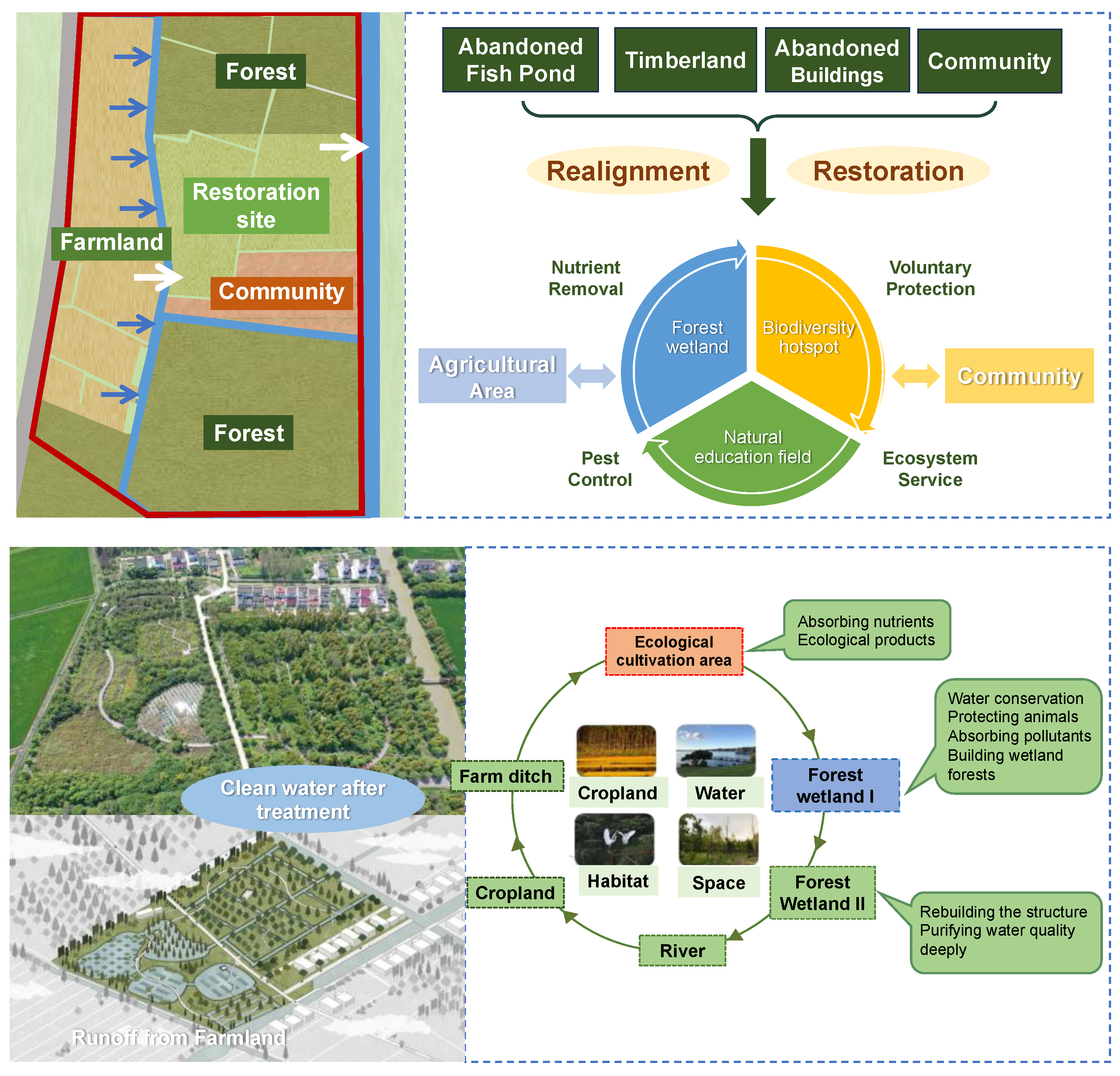
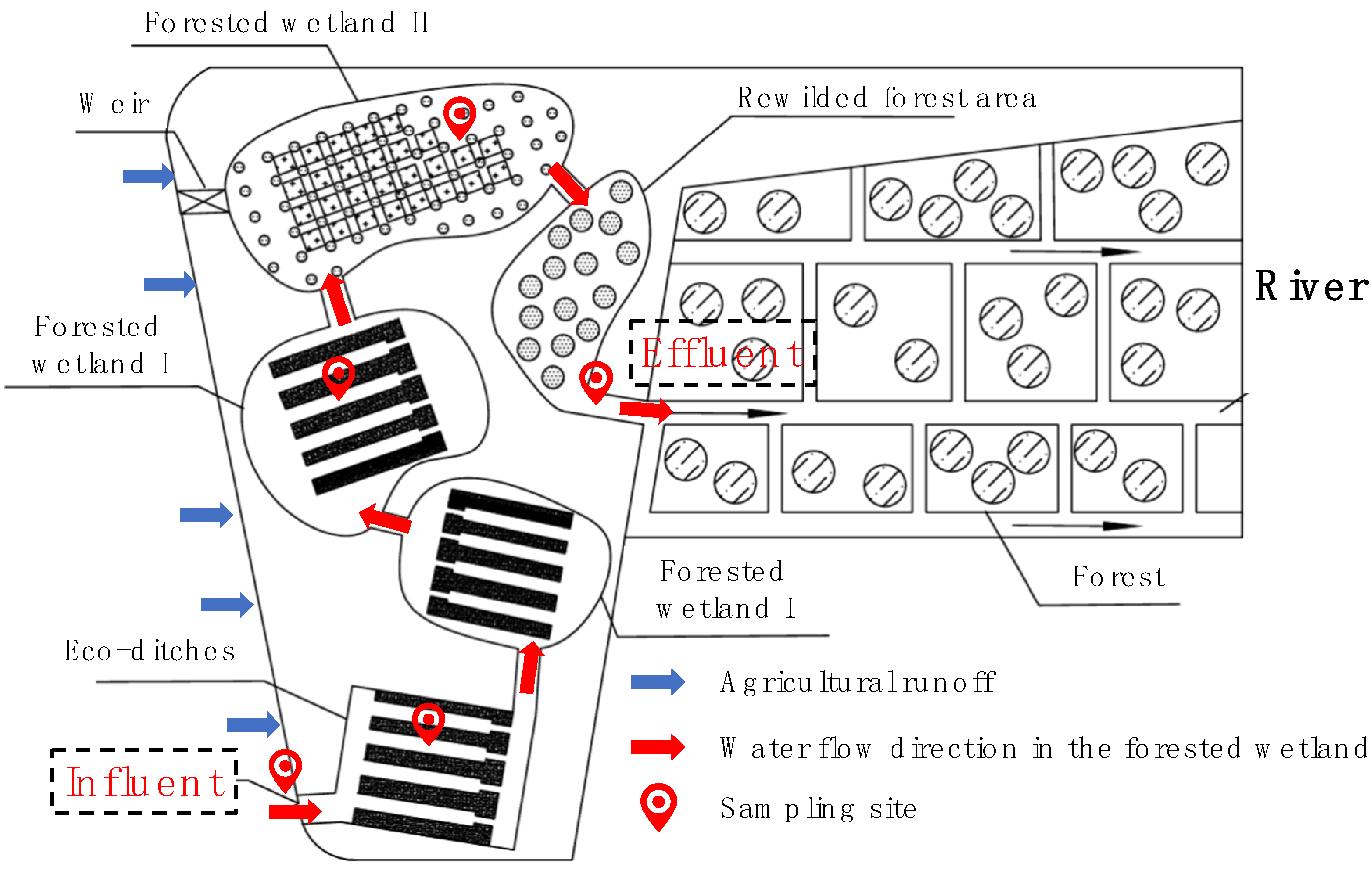
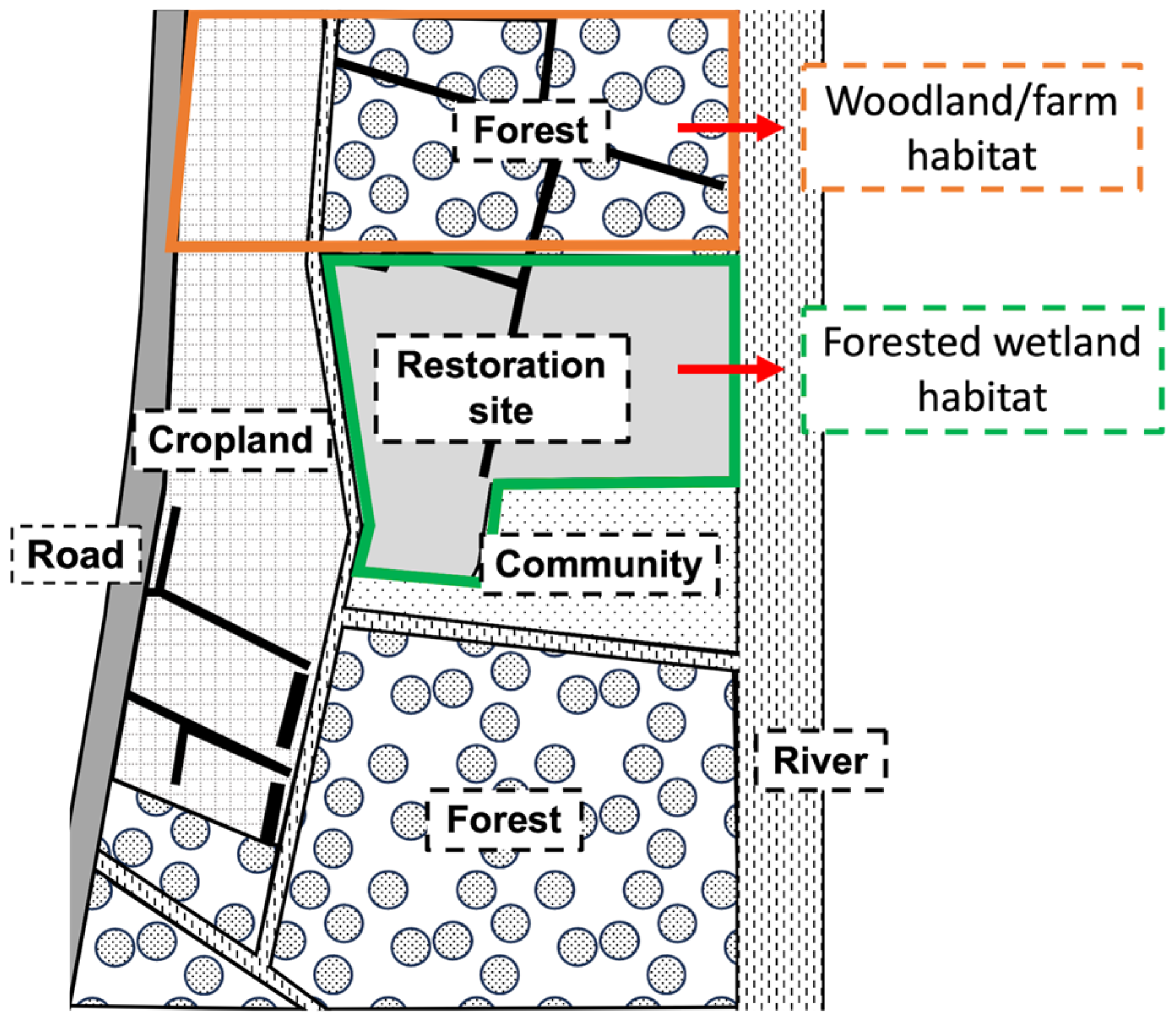
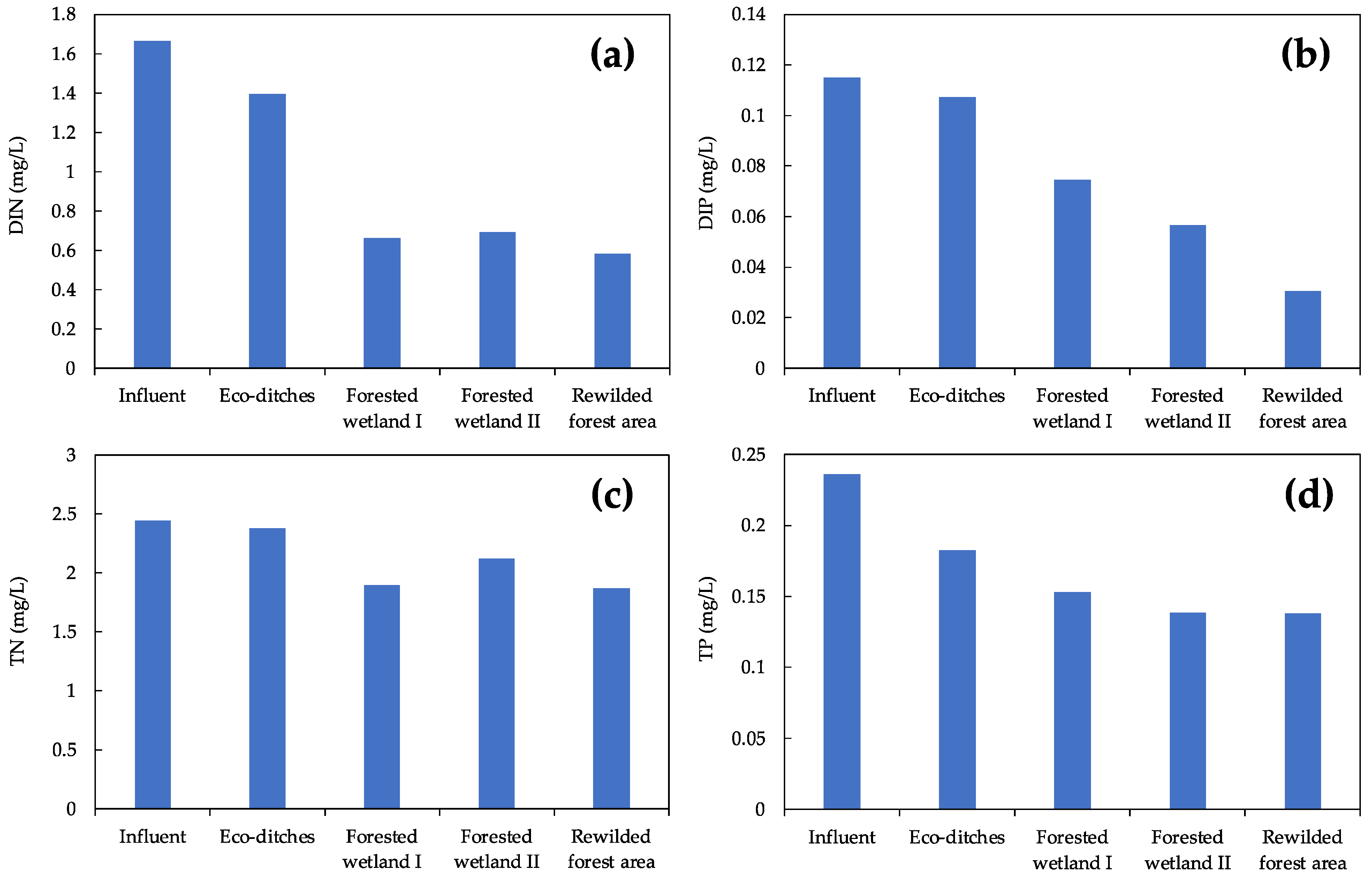
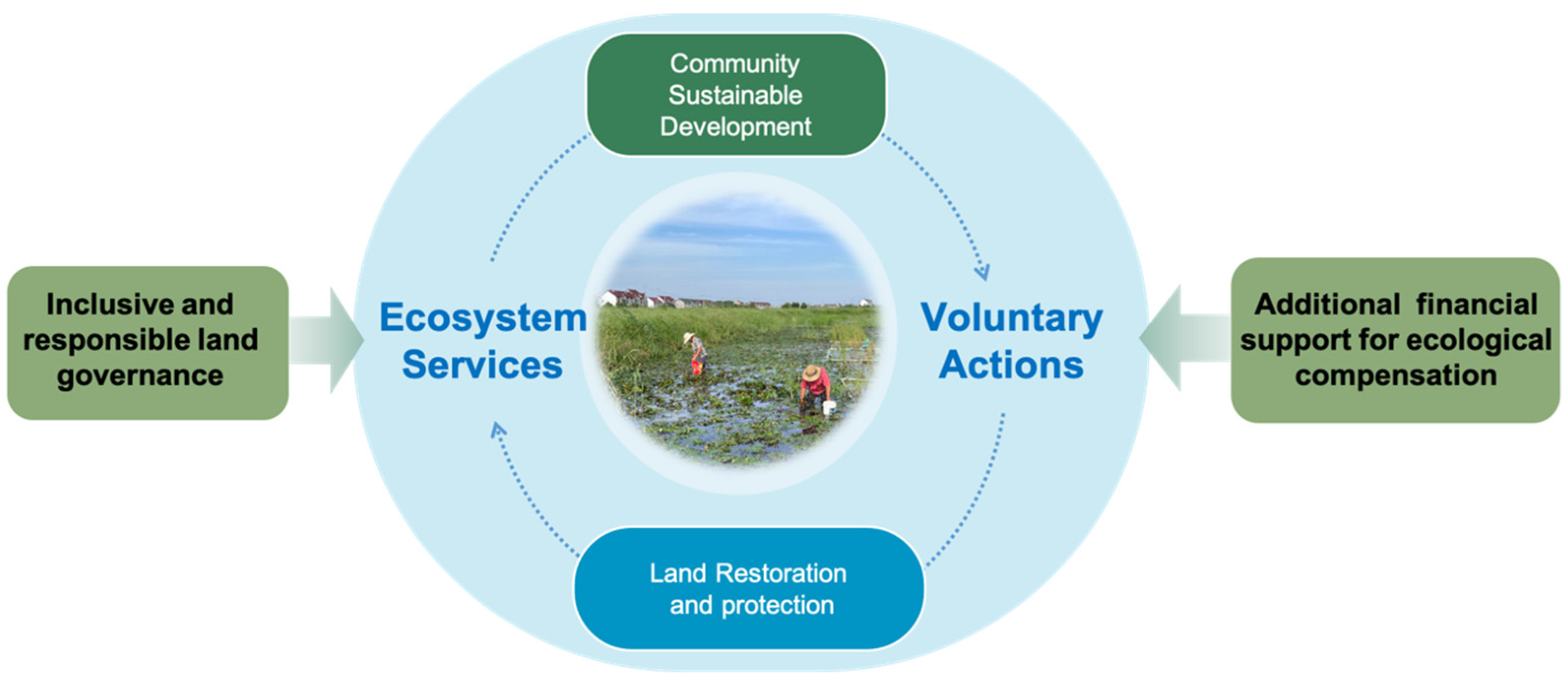
| Indicator | NH4-N | NO3-N | DIN | DIP | TN | TP |
|---|---|---|---|---|---|---|
| Influent (mg/L) | 0.31 (0.03~0.80) | 1.22 (0.39~2.85) | 1.66 (0.063~2.95) | 0.12 (0.02~0.45) | 2.44 (1.04~6.53) | 0.24 (0.10~0.60) |
| Effluent (mg/L) | 0.16 (0.02~0.39) | 0.36 (0.16~0.50) | 0.58 (0.34~1.00) | 0.03 (0.01~0.14) | 1.87 (0.84~3.92) | 0.14 (0.07~0.32) |
| Removal rate mg/(m2·d) | 9.0 | 52.2 | 65.6 | 5.1 | 34.8 | 5.9 |
| Only in One Single Habitat | In Both Habitats | ||
|---|---|---|---|
| Forested Wetland Habitat | Woodland/Farm Habitat | ||
| Number of species | 24 | 2 | 22 |
| Proportion of total species | 50.0% | 4.2% | 45.8% |
| Abundance | 128 | 15 | 411 |
| Proportion of total abundance | 23.1% | 2.7% | 74.2% |
Disclaimer/Publisher’s Note: The statements, opinions and data contained in all publications are solely those of the individual author(s) and contributor(s) and not of MDPI and/or the editor(s). MDPI and/or the editor(s) disclaim responsibility for any injury to people or property resulting from any ideas, methods, instructions or products referred to in the content. |
© 2025 by the authors. Licensee MDPI, Basel, Switzerland. This article is an open access article distributed under the terms and conditions of the Creative Commons Attribution (CC BY) license (https://creativecommons.org/licenses/by/4.0/).
Share and Cite
Huang, Z.; Sun, Y.; Sheng, R.; He, K.; Wang, T.; Huang, Y.; Chen, X. Creating Forested Wetlands for Improving Ecosystem Services and Their Potential Benefits for Rural Residents in Metropolitan Areas. Water 2025, 17, 1682. https://doi.org/10.3390/w17111682
Huang Z, Sun Y, Sheng R, He K, Wang T, Huang Y, Chen X. Creating Forested Wetlands for Improving Ecosystem Services and Their Potential Benefits for Rural Residents in Metropolitan Areas. Water. 2025; 17(11):1682. https://doi.org/10.3390/w17111682
Chicago/Turabian StyleHuang, Zhuhong, Yanwei Sun, Rong Sheng, Kun He, Taoyu Wang, Yingying Huang, and Xuechu Chen. 2025. "Creating Forested Wetlands for Improving Ecosystem Services and Their Potential Benefits for Rural Residents in Metropolitan Areas" Water 17, no. 11: 1682. https://doi.org/10.3390/w17111682
APA StyleHuang, Z., Sun, Y., Sheng, R., He, K., Wang, T., Huang, Y., & Chen, X. (2025). Creating Forested Wetlands for Improving Ecosystem Services and Their Potential Benefits for Rural Residents in Metropolitan Areas. Water, 17(11), 1682. https://doi.org/10.3390/w17111682







